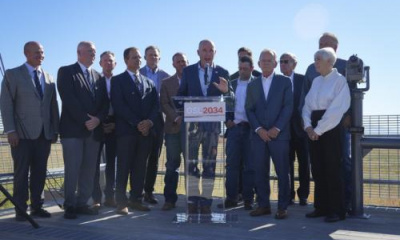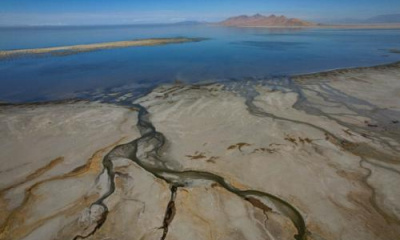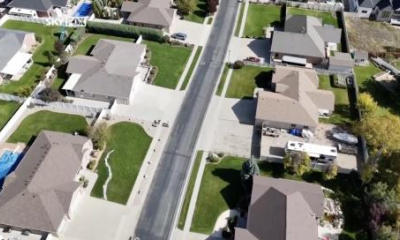Activists and experts from across the state gathered Saturday to discuss problems facing the Great Salt Lake after a historic winter.
The People’s Great Salt Lake Summit, hosted at Salt Lake City Community College’s Miller Campus in Sandy, welcomed over 200 people on a sunny summer Saturday to discuss problems facing the Great Salt Lake.
The summit was put on by local organizations including Utah Physicians for a Healthy Environment, Save Our Great Salt Lake and the Utah Rivers Council, among others. Doctors, indigenous leaders and local professors explained the impacts of the lake’s shrinking — and all agreed that even though the state’s snow-packed winter provided a much-needed respite, Utahns have to keep pushing to protect the water body.
Current conditions
Bonnie Baxter, director of the Great Salt Lake Institute and a biology professor at Westminster University, updated attendees on the lake’s summer status — which has been overblown by some, she said.
The south arm of the lake — separated from the north arm of the lake by an emergency berm on the railroad causeway — has a more vibrant ecosystem with lower salinity since that’s where rivers flow into the lake, Baxter said. The berm was raised to protect the lake’s south arm, and now that the lake has received more inflow from a historic snowpack, water is spilling over that berm into the lake’s north arm.
The lake’s ideal elevation is 4,200 feet, Baxter said. Current measurements show that the south arm of the lake rose from about 4,189 feet last October to 4,194 feet — but the north arm of the lake rose only about a foot, and was measured at about 4,190 feet earlier this month, according to a recent study from Utah State University.
This makes the lake’s overall rise equal about 3.6 feet — which will shrink to about a 1.2 foot increase by the fall due to summer evaporation, Baxter said.
“The future is not likely to bring us conditions that conserve water in the natural system,” Baxter said. “We might be a foot up at the end of things this year. We need to be 11 feet up — are we going to get 11 winters in a row like this? Absolutely not.”
And as temperatures are predicted to rise in the years ahead, the Wasatch Front is also likely to get more rain and less snow — which doesn’t recharge water bodies as well as snowpack, Baxter said.
“We have to keep the pressure on,” Baxter said. “We need to revalue water, not monetarily, but with a system of love and cherishing the water. We need to address the consumptive uses, that’s for sure.”
Impacts and solutions
One of the biggest impacts of the Great Salt Lake’s shrinkage is with air pollution and its effects on public health. In Utah, air pollution comes from a variety of sources: ozone, wildfires, dust storms and inversions, said Dr. Brian Moench, board chair of Utah Physicians for a Healthy Environment.
Utah’s winter inversions concentrate fine particulate matter when warmer air at higher altitudes creates a “lid” trapping colder air and pollution. And as temperatures rise due to climate change, ozone levels and wildfires have increased as well, Moench said.
“Now we’re seeing dust storms,” Moench said. “About 15 years ago, we didn’t really have any dust storms from the Great Salt Lake, but now we’re having about 15 a year. And this is what we’re really worried about when it comes to what’s going to happen with the Great Salt Lake.”
These dust storms can contain harmful substances like particulate matter, heavy metals, radioactive isotopes and microorganisms — which can cause diseases like meningitis, Moench said.
“Even if you don’t have symptoms, your health has been impaired,” Moench said. “The average person is losing about two years of their life expectancy from this level of air pollution exposure. On the Wasatch Front it’s probably that or maybe even three.”
And these problems will affect people disproportionately, said racial and climate justice organizer Luis Miranda. Areas closer to the Great Salt Lake — on the west side of the valley, like Rose Park, West Valley City and Magna — will be the first to bear the brunt of the lake’s shrinking, he said.
“Climate change means sacrifice zones, sacrifice zones mean disposable people, and for us to have disposable people means racism,” Miranda said. “Those areas areas are where we have the Gadsby Power Plant from Rocky Mountain Power, the refineries, we have an international airport, we have the other private airports, we have all this traffic that is going through an industrial zone, we have U.S. Magnesium. Sacrifice zones are those zones where we have chosen that it’s OK to go ahead and pollute and get out of balance.”
The selection of these sacrifice zones is rooted in white supremacy, Miranda said, so getting Black and Indigenous people involved in the stewardship of the Great Salt Lake is crucial to coming up with solutions to its environmental problems.
“We talked about all these important issues that happen in the valley. But I don’t think that the voices of those that are directly impacted by the Great Salt Lake are often in the conversation,” Miranda said. “Justice really is not just getting to the right place with nature, but also in the process. We need to include those that are impacted and stop making decisions for others.”
Miranda said engaging in related issues — like redlining, unaffordable housing and racial justice — must be analyzed to empower others to get involved in saving the water body.
“When we conceive it that way, then the possibilities of who we organize and how we organize change,” Miranda said. “Dignifying the lives that are most impacted feels important, and if we don’t include them in the solutions, honestly, we were not going to have the long-term solutions we need.”








